Physical Address
304 North Cardinal St.
Dorchester Center, MA 02124
Four decades after the initial recognition of acquired immunodeficiency syndrome (AIDS) in 1980 and the subsequent identification of the human immunodeficiency virus (HIV; which exists in two types: HIV-1, which is the predominant circulating type, and HIV-2), the HIV pandemic remains one of the leading causes of death worldwide. Early efforts at prevention and treatment with antiretroviral drugs tempered the spread and decreased the fatality rate in some countries. In low-income countries, however, where the social, demographic, cultural, and economic impact of the AIDS epidemic had been the greatest, these gains were initially too limited and too slow to reverse the escalating trend of the epidemic. Over the past two decades, with the increased availability of antiretroviral drugs and other prevention interventions, including voluntary medical male circumcision, the rate of new HIV infections has decreased and mortality has declined in most settings.
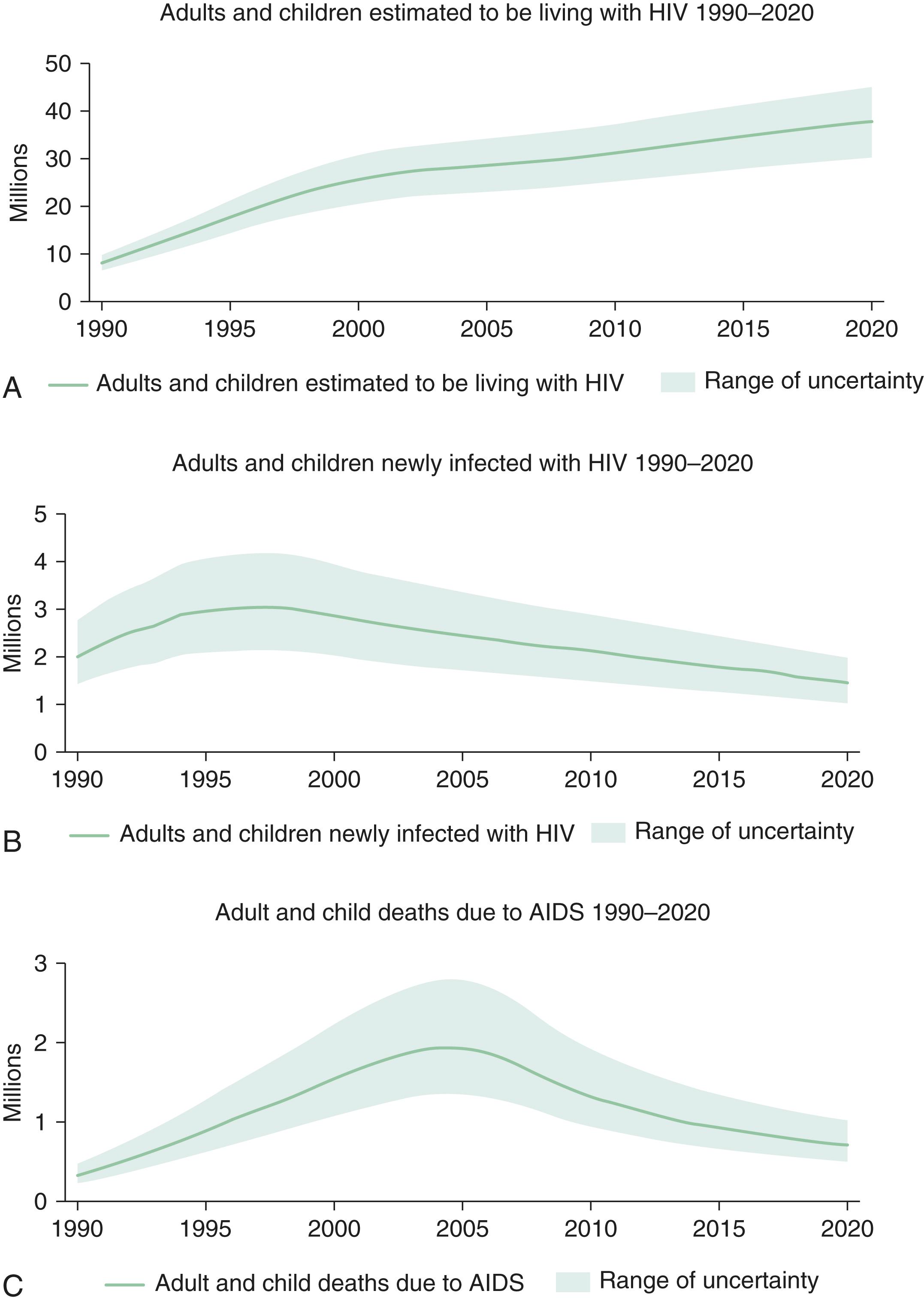
Since the HIV epidemic began in the first half of the 20th century, more than 79 million people have been infected with HIV and 36 million people have died of HIV. At the end of 2020, according to estimates by the Joint United Nations Program on HIV/AIDS (UNAIDS), 37.7 million people were living with HIV ( Table 353-1 and E-Fig. 353-1A ). Adults constituted the majority of those infected; children (persons less than 15 years of age) accounted for 1.7 million of the infected. Globally, people living with HIV were evenly divided by gender, although there was substantial regional variation. Sub-Saharan Africa continued to have the majority of persons living with HIV and the highest HIV prevalence rates, but large epidemics are present worldwide ( Fig. 353-1 and see Table 353-1 ). The continuing rise in the population of people living with HIV infection reflects the combined effects of continued HIV transmission and the beneficial impact of antiretroviral therapy, resulting in fewer deaths.
| REGION | ADULTS AND CHILDREN LIVING WITH HIV/AIDS | ADULTS AND CHILDREN NEWLY INFECTED WITH HIV | ADULT AND CHILD DEATHS DUE TO AIDS | PEOPLE ACCESSING TREATMENT |
|---|---|---|---|---|
| Eastern and southern Africa | 20,600,000 | 670,000 | 310,000 | 16,000,000 |
| Western and central Africa | 4,700,000 | 200,000 | 150,000 | 3,500,000 |
| North Africa and Middle East | 230,000 | 16,000 | 7900 | 96,000 |
| Asia and the Pacific | 5,800,000 | 240,000 | 130,000 | 3,700,000 |
| Latin America | 2,100,000 | 100,000 | 31,000 | 1,400,000 |
| Caribbean | 330,000 | 13,000 | 6000 | 220,000 |
| Eastern Europe and central Asia | 1,600,000 | 140,000 | 35,000 | 870,000 |
| Western and central Europe and North America | 2,200,000 | 67,000 | 13,000 | 1,900,000 |
| GLOBAL | 37,700,000 | 1,500,000 | 680,000 | 27,500,000 |
∗ Numbers are rounded estimates from the Joint United Nations Programme on HIV/AIDS.
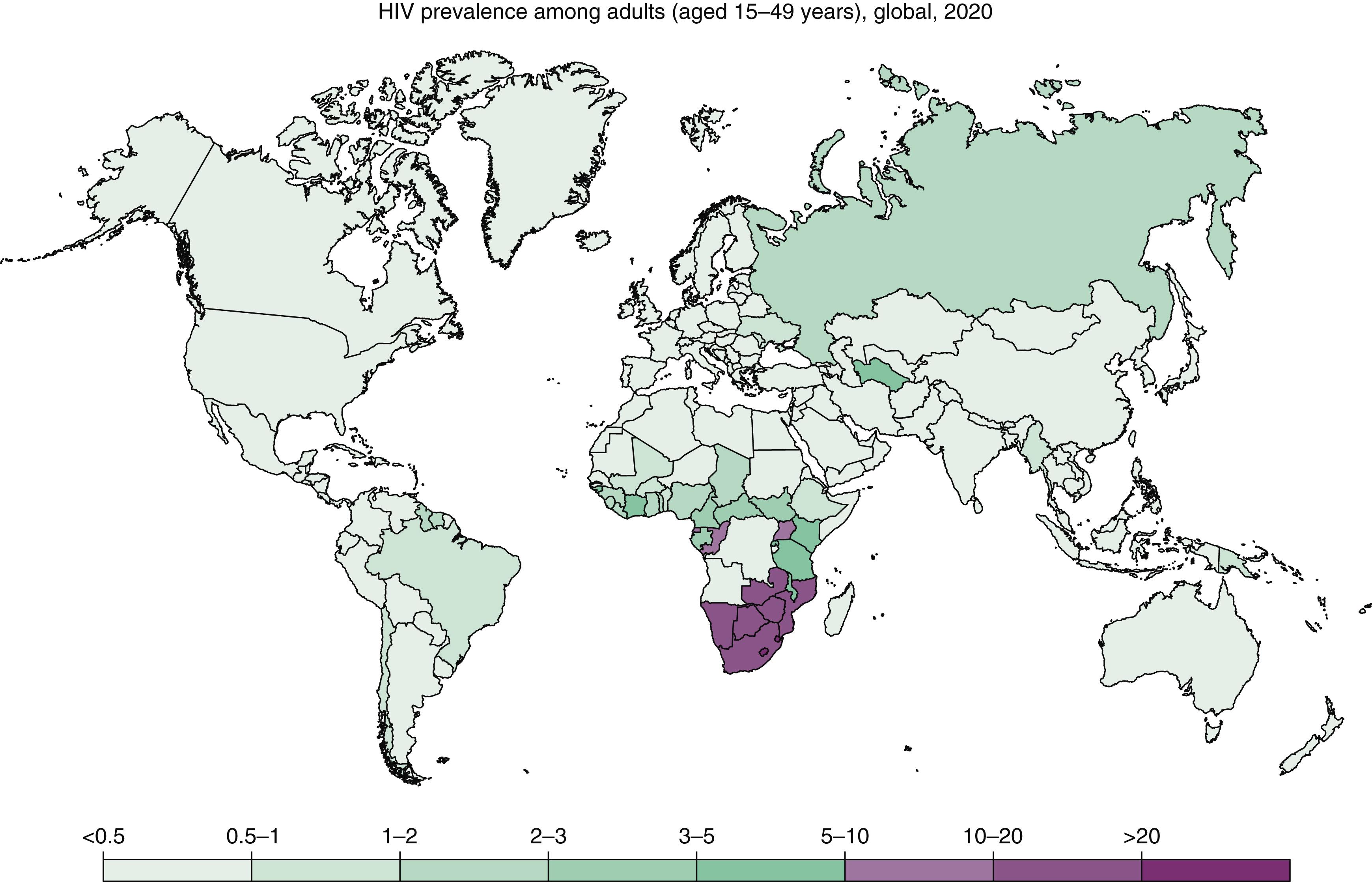
In 2020, the 1.5 million people who became newly infected with HIV globally represented a decline of 31% since 2010 and a marked decline from the more than 3 million infections per year experienced during the peak of the epidemic in the 1990s (see E-Fig. 353-1B and Table 353-1 ). These declines have been most prominent among children, in whom new infections have decreased by 53% since 2010; decreases in adults have occurred more slowly. Despite this progress, declines remained well short of United Nation’s 2020 targets of 500,000 infections per year. Progress has also been uneven across regions, with the steepest declines in new HIV infections in eastern and southern Africa (43%) compared with a troubling 43% rise in new infections in eastern Europe and central Asia. Low- and middle-income countries constitute more than 90% of new infections, and sub-Saharan Africa alone accounts for 58% of all new HIV infections globally.
The major mode of HIV transmission globally in 2020 was heterosexual transmission, although infections continue to spread at high rates among key populations such as men who have sex with men and people who inject drugs. These and other key populations continue to play important roles in all major regional epidemics ( E-Fig. 353-2 ). Outside of sub-Saharan Africa, key populations and their partners accounted for 93% of new HIV infections in 2020. In sub-Saharan Africa, they accounted for 39% of new HIV infections. Globally, women acquire new HIV infections at roughly the same rate as men. However, new infections in young women aged 15 to 24 years were 80% higher than in men, a figure that is a particular concern because this age group accounted for 28% of all new HIV infections in 2020 and is part of an ongoing demographic youth bulge.

HIV continues to be a major source of global morbidity and mortality, although significant progress has been made in scaling up life-saving treatment. Deaths from HIV have declined from a peak of 1.9 million deaths in 2005 to 680,000 deaths in 2020 ( Fig. 353-1C ), likely owing to increased HIV treatment access and fewer new HIV infections. Gender disparities in mortality are substantial, with declines in deaths about 25% lower among men compared with women, likely because of higher HIV treatment uptake among women. There have been even sharper declines in child mortality due to HIV, with less than 90,000 deaths in 2020 compared with 210,000 in 2010, a 60% decline. Similar to reductions in new HIV infections, declines in deaths due to AIDS-related illnesses have been most pronounced in eastern and southern Africa. In contrast, there have been concerning increases in AIDS-related mortality in some countries in the Middle East and North Africa and eastern Europe and central Asia.
For the first two decades of the epidemic, fatality rates from AIDS steadily increased, and the average life expectancy in some countries in sub-Saharan Africa declined from 62 to 47 years of age. For example, in Haiti, life expectancy was nearly 6 years less than it would have been in the absence of AIDS. Cambodia experienced a reduction in life expectancy of more than 4 years. In 1995 in the United States, AIDS was the leading killer of Americans aged 25 to 44 years. Globally, HIV has now claimed an estimated 36 million lives.
Beginning in 1996 in high-income countries, the advent of combination antiretroviral therapy for HIV infection led to dramatic declines in HIV-associated mortality. In low-income and most middle-income countries, the Global Fund for AIDS, Tuberculosis, and Malaria as well as the United States President’s Emergency Plan for AIDS Relief (PEPFAR) continue to provide treatment and care for people living with HIV globally, as well as resources for enhancing prevention efforts to stop further transmission. WHO treatment guidelines recommend antiretroviral therapy to all people living with HIV regardless of CD4 count and encourage universal access to HIV testing and care as part of a cascade framework of prevention and care ( E-Fig. 353-3 ).
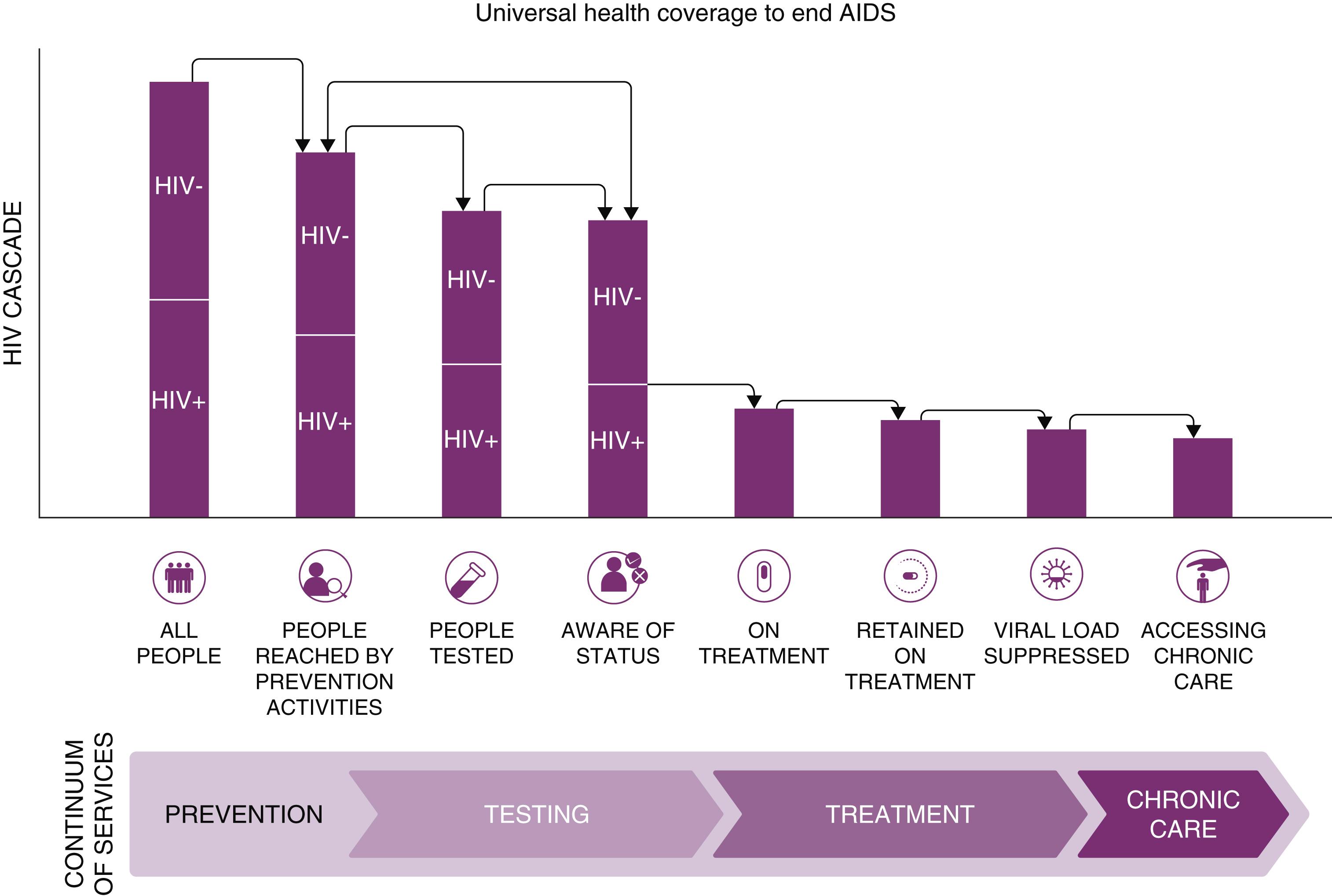
As of 2020, an estimated 84% of people living with HIV globally were aware of their HIV status. Among those who know their status, an estimated 87% were on treatment, meaning that among all people living with HIV, about 73% were on treatment ( Fig. 353-2 ). Of people on treatment, an estimated 90% were virally suppressed. Thus, in 2020, about 66% of all people living with HIV were virally suppressed. Although these figures represent remarkable progress from the early 2000s, significant gaps in testing and care remain. There is also considerable regional variation, with targets being met in some countries in western and central Europe and sub-Saharan Africa, but less so in eastern Europe and central Asia, the Middle East, and North Africa. Key success stories include Botswana, the first country in Africa to have reached UNAIDS 90-90-90 targets (90% of all people living with HIV will know their HIV status, 90% of those diagnosed are on antiretroviral therapy, and 90% of those on treatment are virally suppressed), and Eswatini, which has achieved a remarkable 97% reported viral suppression among all people living with HIV.
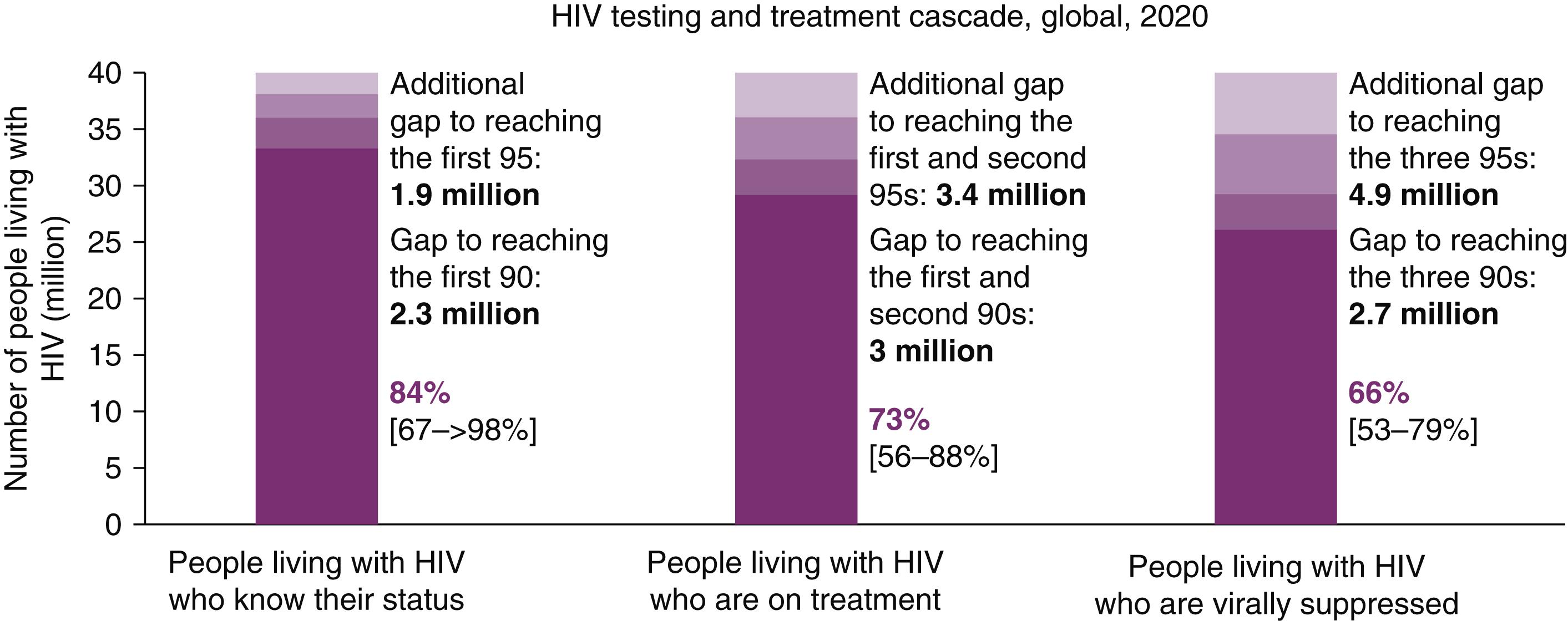
Regarding HIV treatment access, in 2020, an estimated 27.4 million people were on treatment, a dramatic increase from 2010 when only 7.8 million people had access to treatment (see Fig. 353-3 ). The trajectory of treatment access has been consistently upward for the past two decades, making the 2025 UNAIDS goals of 95% of people living with HIV on antiretroviral therapy a real possibility. People living with HIV also appear to be accessing antiretroviral therapy earlier after initial HIV infection. As a result of the rapid increases in treatment, life expectancy losses have been largely reversed in many countries (see E-Fig. 353-5 ). Among insured adults in the United States, life-expectancy at age 21 years is estimated to be another 57 years among HIV-treated patients compared with 64 years in uninfected people. Globally, an estimated 16.6 million AIDS-related deaths have been saved due to antiretroviral therapy. Expanded treatment access to pregnant women living with HIV has already resulted in large declines in mother-to-child transmission of HIV.
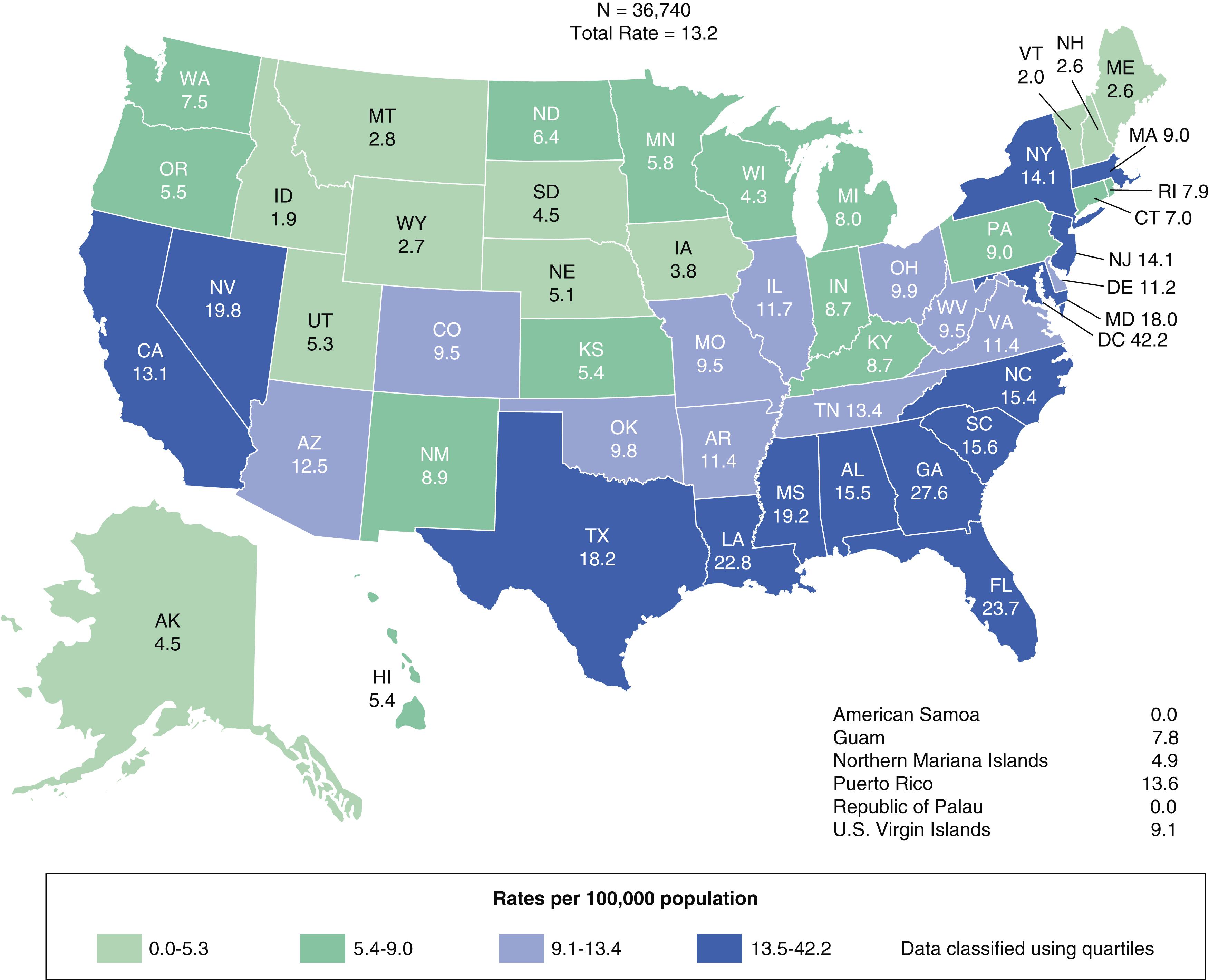
Although progress in HIV prevention and treatment service access has been impressive, remaining challenges include a significant gender disparity, with men globally having lower knowledge of HIV status (82%) compared to women (88%), lower coverage of antiretroviral therapy (68%) compared with women (79%), and lower HIV viral suppression (62%) compared with women (72%). Young people living with HIV are less likely to know their HIV status, be on treatment, and have suppressed viral loads compared with older age groups. Key populations, including sex workers, men who have sex with men, people who inject drugs, transgender people, and prisoners have additional barriers to testing and care, and resulting gaps in the HIV prevention and care cascade. HIV viral load testing access has increased rapidly, but more than half of persons on treatment remain without periodic viral load testing. In almost all target countries, global uptake of voluntary medical male circumcision, which reduces the risk for HIV acquisition among heterosexual men by about 55% and among men who have sex with men by about 20%, remains well below World Health Organization targets of 90%. Condoms, an effective HIV prevention tool, remain underused. Globally, comprehensive harm reduction programs for people who inject drugs, including needle-syringe programs and opioid substitution therapy, are also infrequently implemented. Finally, stigma, discrimination, gender-based violence, and HIV criminalization laws hinder HIV service uptake and retention, particularly among key populations.
Numerous strategies can help the continuing global response to overcome existing challenges across the continuum of prevention and care. These strategies include the gradual expansion of preexposure prophylaxis (PrEP; Chapter 356 ), either on-demand or daily among high-risk HIV-negative persons ( E-Fig. 353-4 ), as well as HIV self-testing and community-based testing to increase awareness of HIV serostatus. Differentiated care, a client-centered approach to HIV service delivery, is another approach being implemented that attempts to simplify and adapt HIV services to individual patient circumstances (e.g., stable people living with HIV on antiretroviral therapy with undetectable viral loads may need fewer provider visits, or a group of people living with HIV may form community-based treatment and support groups). In many global settings, new, less expensive, and improved antiretroviral therapy, such as integrase-based regimens, has improved access and outcomes. In the years to come, additional resources will be required to reach the additional millions of HIV-infected people who require treatment, retain those on treatment, and reach the millions of HIV-negative persons who would benefit from HIV prevention services.
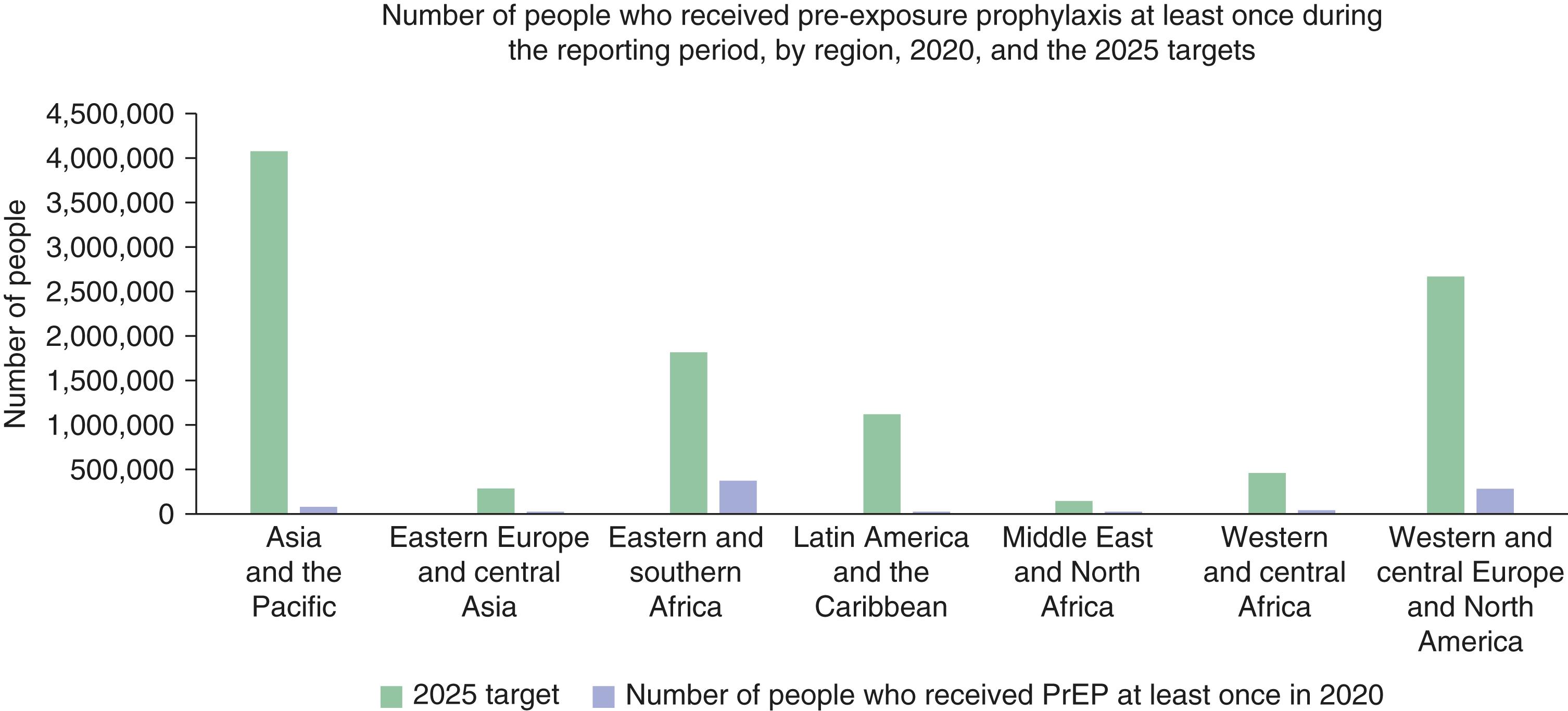
The 21 countries that make up eastern and southern Africa represent the epicenter of the global HIV/AIDS pandemic (see Table 353-1 ). More than half of all people living with HIV reside in eastern and southern Africa. HIV prevalence varies widely across countries. The highest HIV prevalence rates in the world are found in Eswatini (27%). South Africa, the most populous country in this region, has an HIV prevalence of 19%. The main mode of transmission in this region is heterosexual sex. The number of new HIV infections in eastern and southern Africa has dropped from 1.1 million in 2010 to 670,000 in 2020, a 43% decline ( E-Fig. 353-5 ). This decline has been even more pronounced in children with a 64% reduction from 2010 to 2020.
Knowledge of HIV status and HIV treatment coverage in eastern and southern Africa has risen steeply over the past decade. In 2020, about 90% of all people living with HIV in this region were aware of their HIV status ( E-Fig. 353-6 ), 78% were on treatment, and an estimated 72% were virally suppressed. Significant progress has also been made with HIV treatment, with an estimated 16 million people on treatment in eastern and southern Africa in 2020, quadruple the number from 2010. As a result, mortality from AIDS-related deaths in this region has dropped by 50% since 2010 to a still substantial 310,000 deaths in 2020 (see E-Fig. 353-6 ). Continued support of HIV treatment and prevention services will be needed if this region is to maintain and build on past advances.

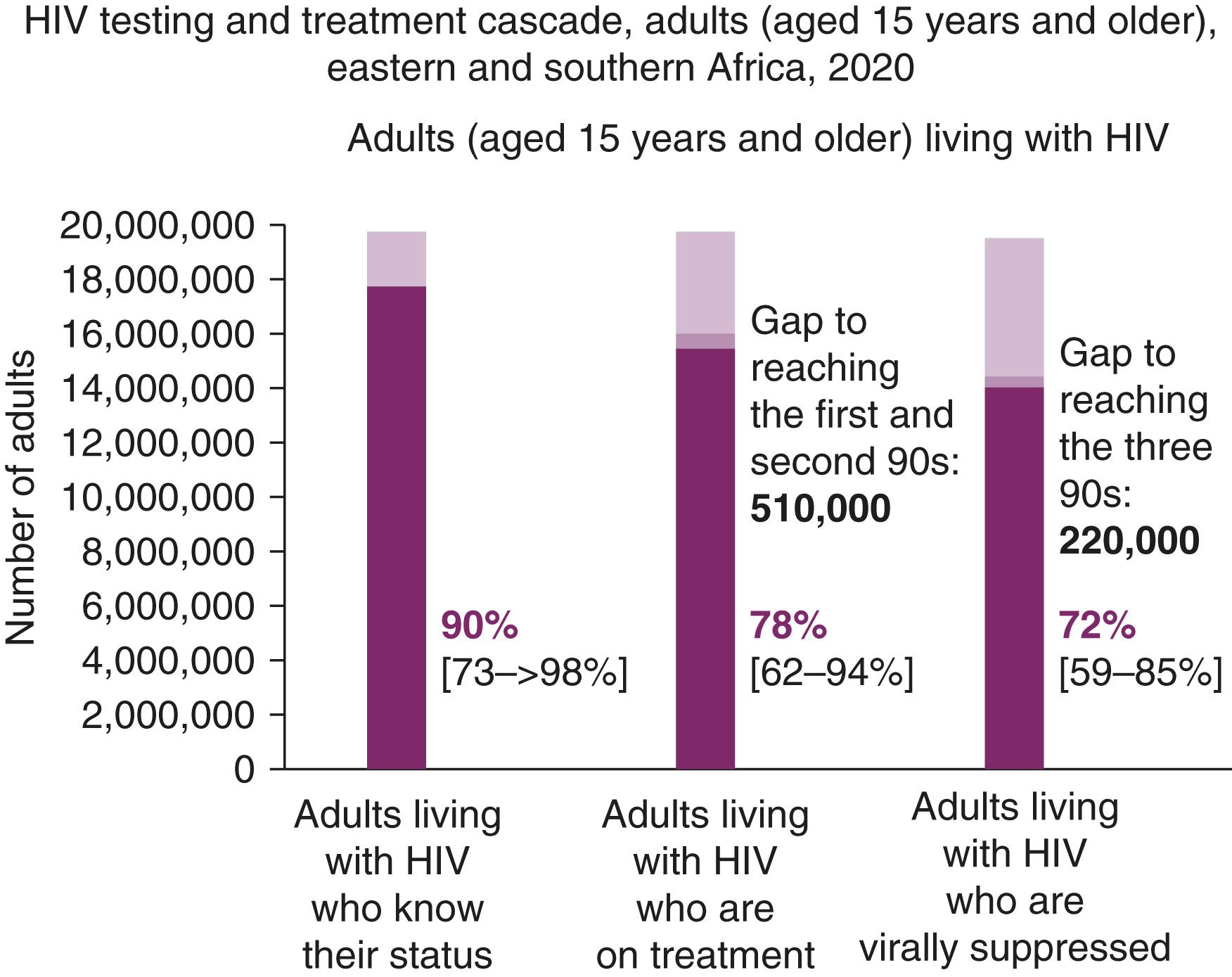
Become a Clinical Tree membership for Full access and enjoy Unlimited articles
If you are a member. Log in here